Introduction
Nikkor AF Nikkor 20mm f/2.8D mounted on a Nikon D3x
With a DxOMark score of 21, the Nikon AF Nikkor 20mm f/2.8D is a good, solid lens.
| Strong points | Weak points |
| Reasonable sharpness | Vignetting |
| Reasonable transmission | Noticeable chromatic aberrations |
| Not much distortion | |
| Not too heavy |
How well does this lens compare to the Sony AF 20mm F2.8, another “antique” but popular lens?
Nikon AF Nikkor 20mm f/2.8D mounted on a Nikon D3x vs Sony AF 20mm f/2.8 mounted on a Sony Alpha 900
With a DxOMark score of only 10, the Sony 20mm’s performance is very limited indeed. With an 11-point lead, the Nikon 20mm is way, way ahead.
The advantages of the Nikon:
- Better correction of chromatic aberrations.
- Superior field resolution at wide apertures (notably at f/2.8 and f/4), which certainly contributes to its far better DxOMark score.
- Not as heavy.
- Less expensive.
The advantage (note the singular!) of the Sony:
- Slightly brighter.
To sum up once again – the Nikon is a beautiful old lens!
Nikon AF Nikkor 28mm f/2.8D mounted on a Nikon D3x
With a DxOMark overall score of 20, the Nikkor AF Nikkor 28mm f/2.8D is still a good, solid lens. (Just as a reminder, the 20mm f/2.8D achieved a DxOMark overall score of 21.)
| Strong points | Weak points |
|
|
Comparison: Nikon AF Nikkor 28mm f/2.8D vs Carl Zeiss Distagon T 28mm f/2 ZF2 Nikon mounted on a Nikon D3x
With a DxO Mark Score of 23, the Carl Zeiss 28mm f/2.0 is the winner of this competition. But at only 3 points behind, the Nikon 28mm f/2.8 should not be dismissed out of hand… especially given that it is five times less expensive (!) than the Zeiss.
The advantages of the Nikon:
- Half the weight of the Zeiss.
- 1000 USD less expensive.
- Negligeable distortion.
- Autofocus (if the camera is equipped with a motor).
The advantages of the Carl Zeiss :
- Better sharpness.
- Brighter: a gain of 0.77EV at full aperture (which explains the difference in DxOMark scores).
- Negligeable distortion.
- Mechanical precision.
Some other available comparisons
The Nikon 28mm AF-D vs the latest in the G prime lens series:
Nikon AF Nikkor 28mm f/2.8D vs Nikkor AF-S Nikkor 24mm f/1.4G ED
Nikon AF Nikkor 28mm f/2.8D vs Nikkor AF-S NIKKOR 35mm f/1.4G
(Yet another opportunity to take note of the amazing progress that has taken place in just a decade!)
Of note:
- As ever when considering Zeiss lenses, it’s important to keep in mind that they do not have autofocus.
- Nikon AF-D lenses do not have self-contained motors and thus are dependent on the camera motor for autofocus.
Here we have analyzed its full-field performance when mounted on a Nikon D3x, but as per usual, performance results are available for this lens when mounted on other cameras — for example, the Nikon D5000 or the even older Nikon D200.
Nikkor AF Nikkor 35mm f/2D mounted on a Nikon D3x
With a DxOMark overall score of 19, the Nikon AF Nikkor 35mm f/2D is still a good lens, just like both the 20mm and 28mm lenses in the AF-D line that we previously analyzed in parts 1 & 2 of our “Oldies” review.
| Strong points | Weak points |
| Satisfactory sharpness | Susceptible to vignetting (a classic problem for this kind of lens) |
| A very bright lens | |
| Very little distortion | |
| Negligeable chromatic aberrations | |
| Very light (205g, just like the 28mm f/2.8D) | |
| Affordable (365 USD) |
Now let’s look at how our older AF-D lens compares with a real youngster (2010)
Nikkor AF Nikkor 35mm f/2D vs Nikon AF-S NIKKOR 35mm f/1.4G (both mounted on a Nikon D3x)
With a DxO Mark score of 27, the 35mm f/1.4G comes out significantly ahead of its predecessor.
The advantages of Nikon 35mm f/1.4G:
- Far superior resolution over the field at wide apertures (notably at f/2.0, f/2.8, and f/4) — which explains the difference in DxOMark scores.
- Brighter, with a gain of 0.61EV in the center at full aperture.
- Negligeable distortion.
- Integrated autofocus motor (SWM, or “silent wave motor”).
- At f/2.0, there is a total absence of vignetting over 2/3 of the field, which is truly remarkable for this kind of fixed lens.
The advantages of the Nikon 35mm f/2.0D:
- Three times lighter!
- About 1400 USD less expensive.
- Negligeable distortion.
- Better treatment of chromatic aberrations.
- Aperture control ring.
Strictly in terms of image quality, the youthful 35mm 1.4G unquestionably takes the lead. But again, it’s important to keep the 35mm f/2.0D’s many charms in mind— i.e., it gets pretty darned good results for an older lens that is both very light-weight and low in price.
While we’re at it, here are a few other 35mm comparisons
Sony 35mm F1.4 G on a Sony A900 vs Nikon 35mm f/2.0D on a Nikon D3x:
Sony still needs to make more progress before it can justify the price difference between its lens and the Nikon 35mm f/2.0.
Samyang 35mm F1.4 AS UMC Nikon vs Nikon AF Nikkor 35mm f/2D, both on a Nikon D3x:
For those who aren’t put off by manual focusing, the Samyang remains competitive in this lens category.
Nikon AF-S DX Nikkor 35mm f/1.8G vs Nikon AF Nikkor 35mm f/2D, both on a Nikon D90:
Finally, here’s how the DX 35mm f/1.8G and our vintage Nikkor 35mm compare when mounted on a Nikon D90.
Nikon AF Nikkor 85mm f/1.8D mounted on a Nikon D3x
With a DxOMark score of 26, the Nikkor AF Nikkor 85mm f/1.8D lens is perfectly able to compete with even the most recent lenses.
| Strong points | Weak points |
| Good sharpness | Susceptible to vignetting |
| A bright lens (conforming to Nikon’s announced values) | |
| Zero distortion | |
| Chromatic aberrations essentially absent | |
| Light-weight | |
| Affordable (380 USD) |
Comparison: Nikon AF Nikkor 85mm f/1.8D vs Nikon AF-S Nikkor 85mm f/1.4G, both mounted on a Nikon D3x
With a DxOMark score of 30, the new generation (2010) Nikkor 85mm f/1.4G offers even better performance.
The advantages of the Nikon 85mm f/1.4G:
- Slightly superior resolution over the field at wide apertures, which explains the difference in DxOMark scores.
- Very slightly brighter (a gain of only 0.16EV in the center at full aperture).
- Negligeable distortion.
- Integrated autofocus motor (SWM).
- At f/2.0, a complete absence of vignetting over approximately 3/4 of the field — a remarkable difference.
The advantages of the Nikon 85mm f/1.8D:
- Half the weight of the f/1.4G.
- Less expensive by about 1740 USD.
- Negligeable distortion.
- Aperture control ring.
Just like its cousins (the 20mm, 28mm and 35mm), the 85 mm is a lens for adventurers — light-weight, inexpensive, and very satisfactory optical qualities.
We’re looking forward to the test results for the new Nikon AF-S NIKKOR 85mm f/1.8G that should arrive in our lab in mid-March!


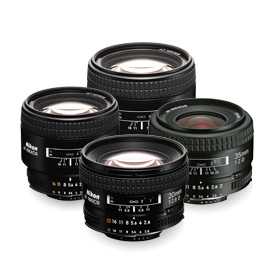
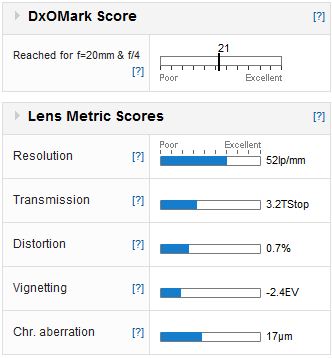
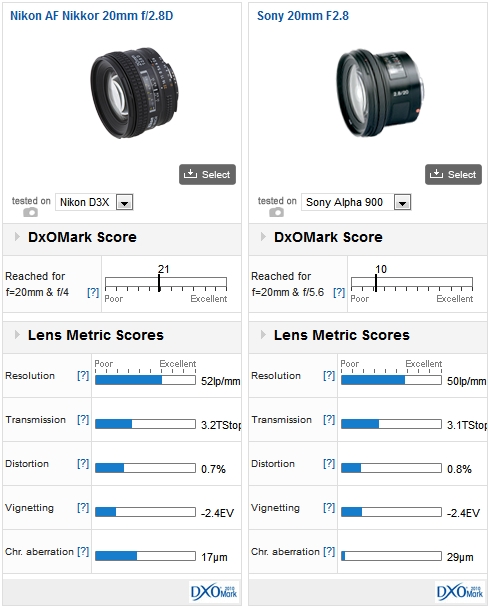
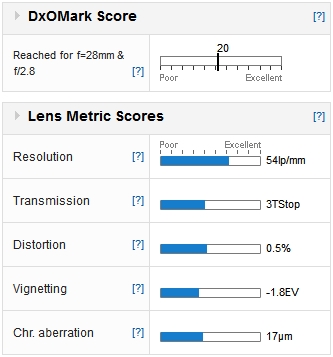
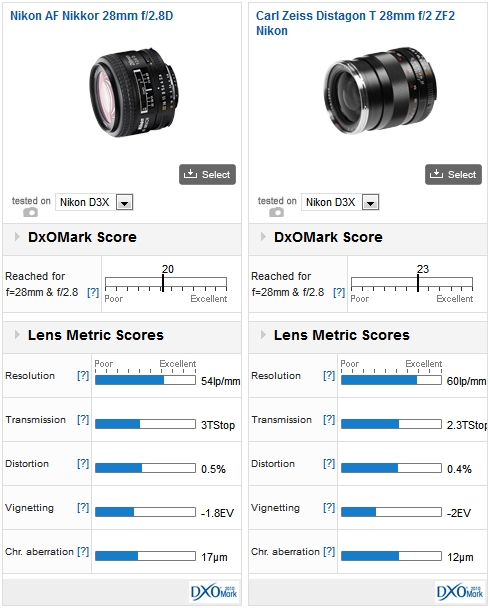
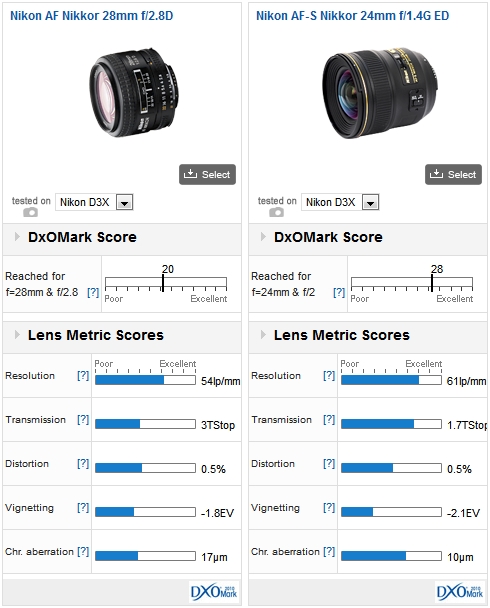
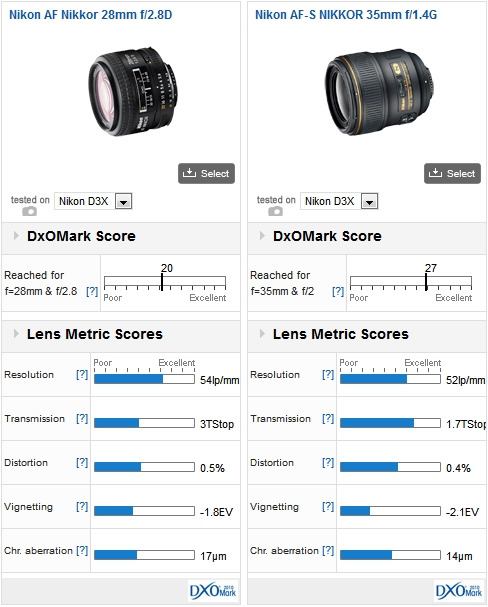
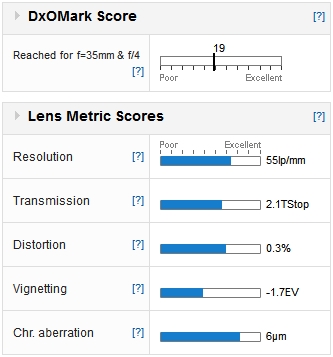
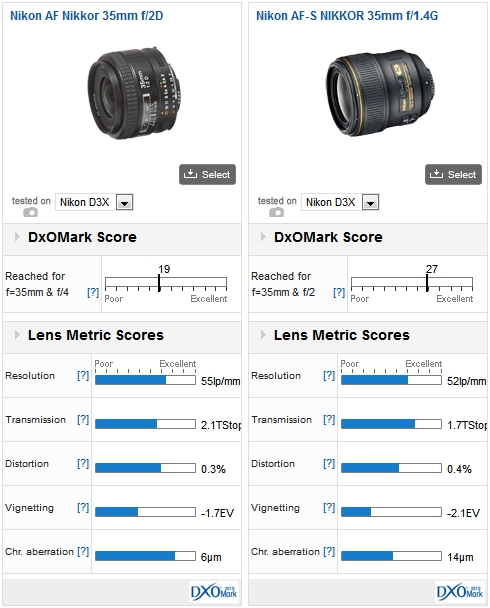
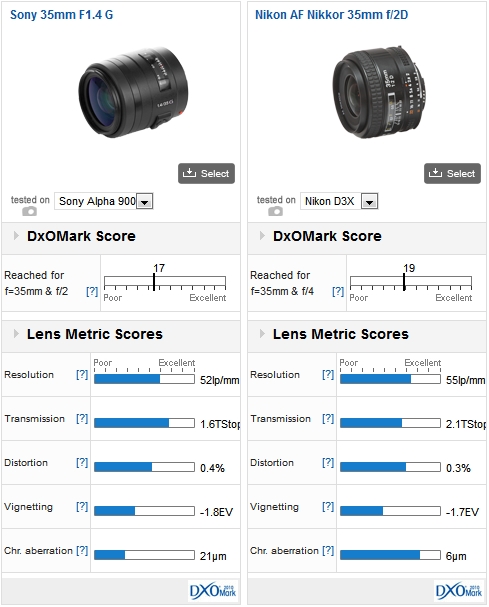
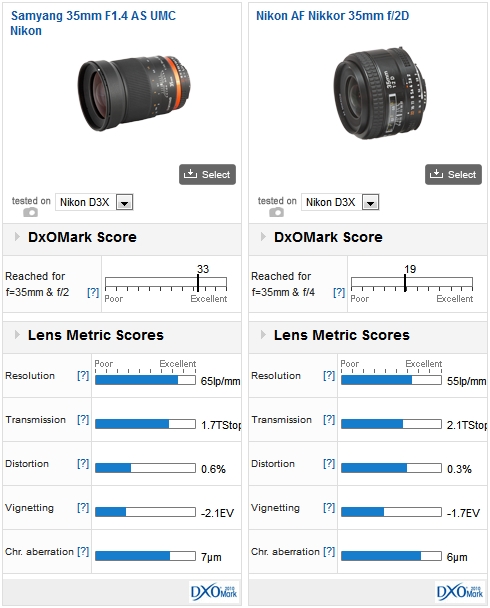
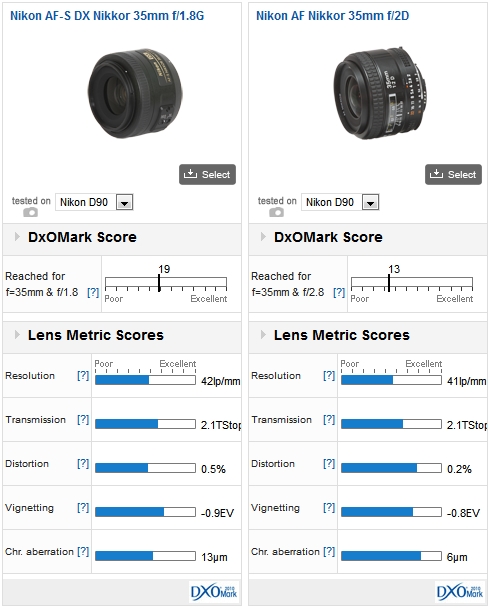
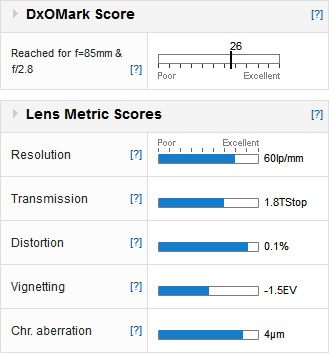
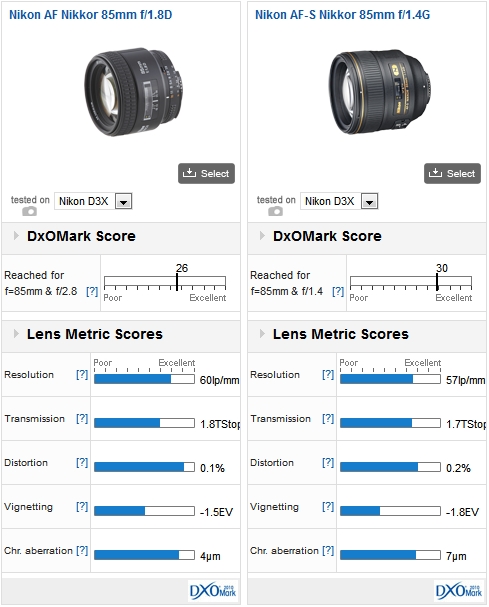
DXOMARK encourages its readers to share comments on the articles. To read or post comments, Disqus cookies are required. Change your Cookies Preferences and read more about our Comment Policy.